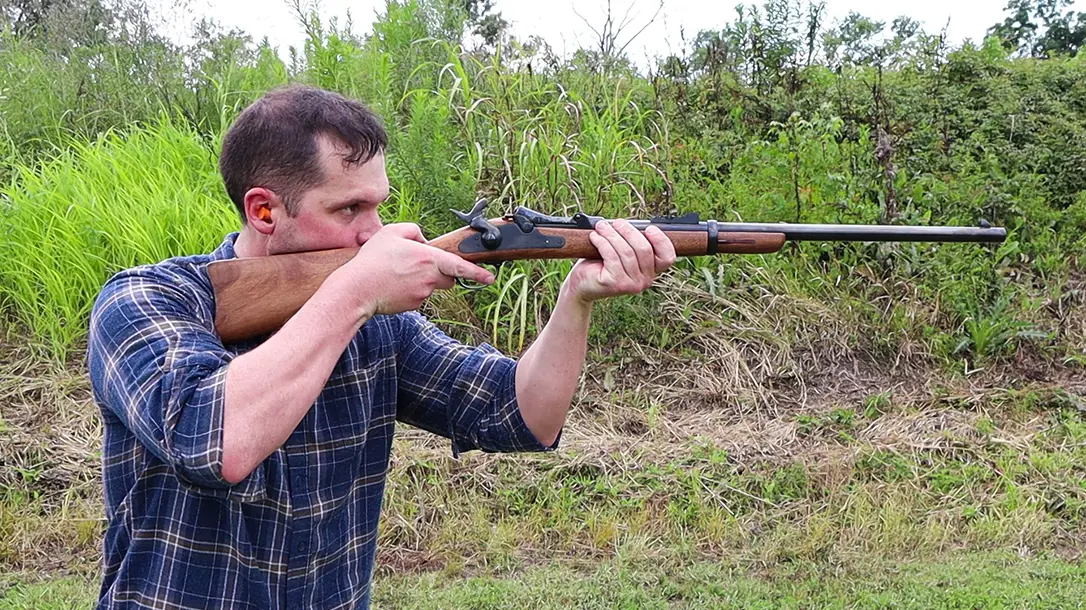Historians lean on precious few events in the year 1873, but if your interests are eclectic enough that year was a good one. Students of new nations might note the start of the Spanish First Republic. Maritime enthusiasts remember the sinking of the SS Atlantic off Nova Scotia. Americanists can point to the start of the Long Depression and the end of silver currency in the Crime of ’73. Firearm enthusiasts remember the Winchester 1873 lever action rifle and Colt’s Single Action Army revolver, two firearms that won the West and defined the era beyond. Less talked about is the 1873 Trapdoor Springfield rifle and the .45-70 cartridge it sported.
The 1873 Trapdoor Springfield – The Army’s First Modern Rifle
Initially dreamed as a stop gap rifle for the US Army, it soldiered on for three decades and earned its place as a third gun that Won the West. After its service, countless Trapdoors were pressed into service with hunters across North America and modified accordingly. But Pedersoli of Italy is producing a fine replica of the Trapdoor Springfield as it was. Currently, the Italian Firearm Group of Amarillo, Texas is importing several versions of the Trapdoor. This review concerns the 1873 Springfield carbine as configured for the US Cavalry.
Advertisement — Continue Reading Below
The Trapdoor Springfield: A Brief History
The 1873 Springfield’s story begins shortly after the American Civil War. The US Army had invested heavily in muzzle-loading rifled muskets at the onset, but it was quickly apparent that breech-loading rifles firing metallic cartridges were the way of the future. When the war ended in 1865, the Army was downsizing, and Congress was short of funds. A new rifle was needed on the cheap.
Erskine S. Allin at the Springfield Armory developed a trapdoor breechloading mechanism for existing rifled muskets and a new cartridge to go with it. The Model 1865 Springfield chambered in .58 rimfire was little more than an 1863 Springfield musket with the breech machined off for a breech block and extractor. Later the barrels were sleeved to .50 caliber for better ballistics and the .50-70 cartridge made its debut the following year. By 1873, funds were coming in to equip the Army in the ongoing Indian Wars. That year, the Colt Single Action Army was adopted as the new service pistol. A few months later, the new-built 1873 Springfield and the .45-70 cartridge were adopted.
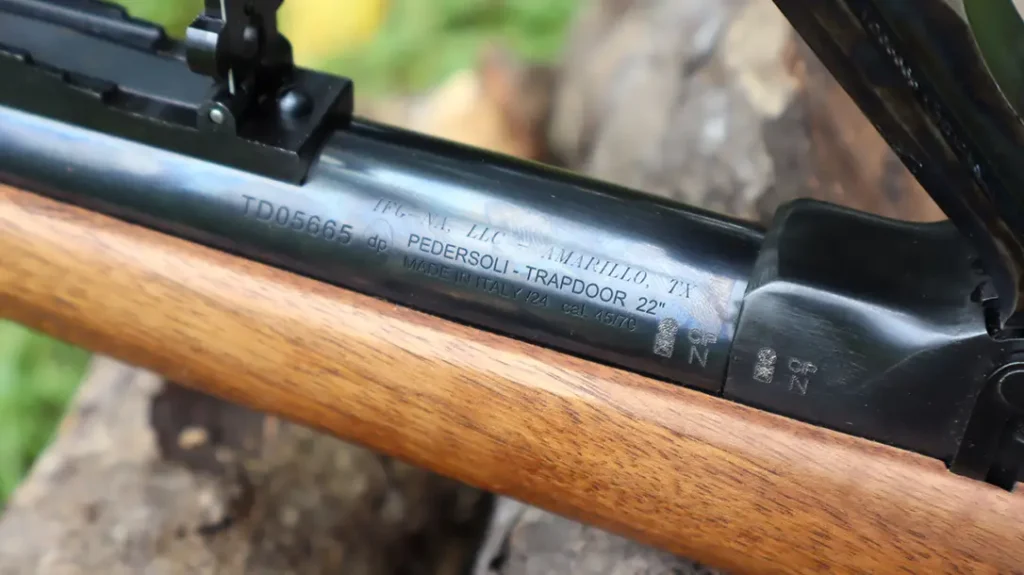
Advertisement — Continue Reading Below
Europe Flocked to Bolt Actions
While Europe abandoned its stop gaps and flocked to bolt actions that later became magazine rifles, the United States kept the single-shot Springfield in service until officially replaced in 1892, but it remained in service through the Spanish-American War and Philippine War at the turn of the 20th century.
Pedersoli’s Trapdoor Rifles and Carbines
After its service, Springfield .45-70 rifles and carbines were surplused for pennies on the dollar. It proved to be a cheap, effective big game rifle in the hands of meat hunters. These rifles went on to endure a hard life of use and modification. David Pedersoli of Italy produces a Trapdoor rifle as originally intended for cowboy action shooters, silhouette games, and historical firearm aficionados.
Pedersoli produces the original full-stock 1873 Infantry rifle with a 32-inch barrel, a 22 inch barreled Cavalry carbine, and higher end models like the 26-inch barreled Officer’s Model. Perhaps the most iconic is the Cavalry model, as seen in the hands of the likes of the Custer’s 7th Cavalry and the US Volunteers at Kettle Hill. This review concerns that model.
Advertisement — Continue Reading Below
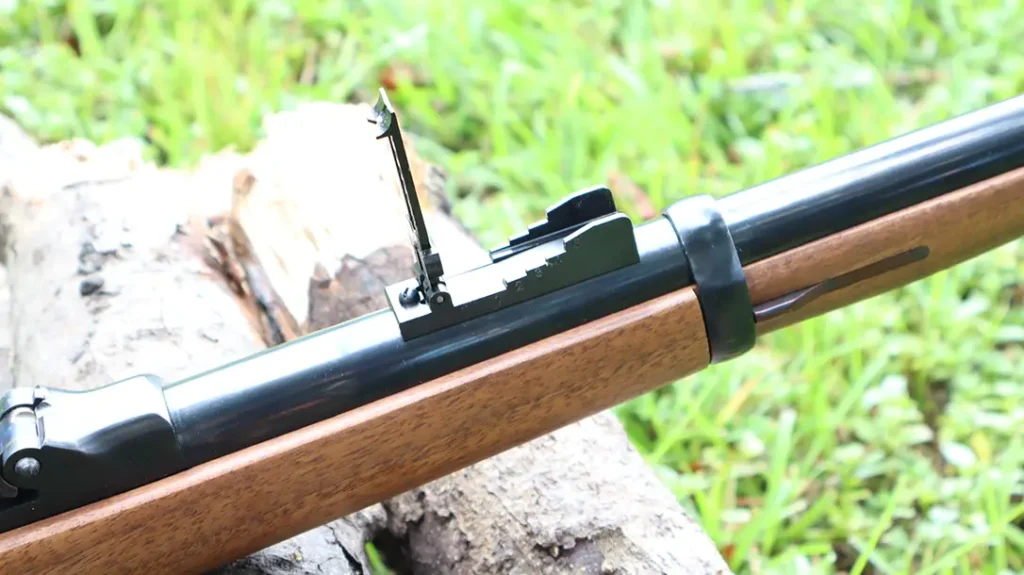
Features
Pedersoli’s 1873 Infantry Rifle has similar dimensions and feels as the rifled muskets of a previous era. Their Cavalry Carbine is a marked departure showing that the Trapdoor Springfield in .45-70 is its own design. The carbine features a blued 22-inch round barrel, a single barrel band, and a half-stock, making it lighter and handier than the former. Instead of conventional sling studs, the Carbine uses a saddle ring for a single point sling.
The sights on the Springfield Carbine consists of a fixed front blade and a v-notch ladder sight. The first five steps of the ladder graduate from 100 yards to 500 yards. The sight then can be raised vertically and the friction-fit notch raised from 600 to 1,100 yards. These ranges are wildly optimistic when we think of the elliptical trajectory of .45-70 Government ammunition but was possible in practice with large bore black powder cartridges of the day.
Advertisement — Continue Reading Below
Aside from these differences, the Carbine is no different from the rifle. The stock is made of oiled American walnut and capped with a color casehardened butt plate. The lock is blued and topped with a laser engraved Springfield Armory cartouche.
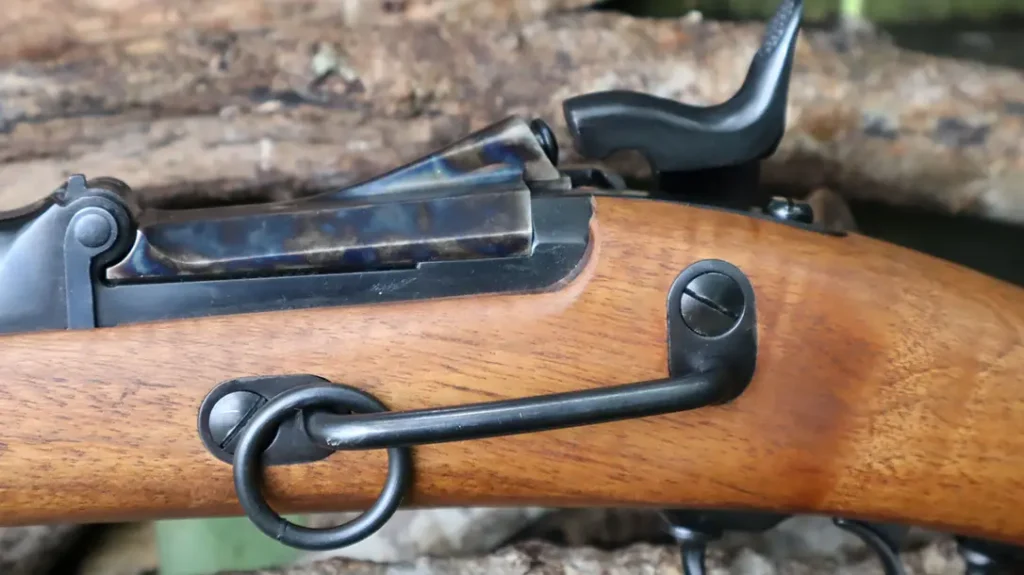
Generous Hammer
The lock itself features a generous hammer with three conditions of carry: a safety notch, a half-cock notch, and full-cock for firing. The trapdoor where the Trapdoor Springfield gets its name, sits under the hammer and is color casehardened. A spring-loaded latch on the right side actuates a square lug in the back of the breech face that allows the user to swing the door up and over on its hinge. At the end of its travel, the ejector cams out and a stationary extractor at the bottom of the chamber kicks any empty cases out.
Advertisement — Continue Reading Below
The Trapdoor originated with the Allin conversion, so named by the director of the Springfield Arsenal Erskine S. Allin. It originated in 1865 to convert existing muzzleloading rifles to a .58 caliber breechloader. The Allin conversion was cheap and fast for a single-shot action, so it was kept with the all-new purpose built 1873 rifles and carbines.
Ammo Considerations
The .45-70 Government cartridge debuted with the Model 1873. It has since jumped from black powder to smokeless and is a popular lever action rifle cartridge, particularly with light, fast jacketed bullets and heavy hard-cast solids.
In spite of these advances, there are plenty of original Trapdoor rifles on there that should not be shot using loads like these. The Trapdoor action, adequate for its time but does not have the action strength of a lever action or a falling block single shot. Original rifles are meant for black powder and black powder pressures.
Advertisement — Continue Reading Below
Pedersoli’s Version
Pedersoli’s version is made with modern steel and smokeless powder in mind, but the limitations of the action remain. Pedersoli rates their rifles at 2200 BAR or 31,908 psi. All rifles are proofed with a 30% overload before shipping. SAAMI rates standard .45-70 Gov’t loads at 28,000 psi. Thus, Pedersoli’s Trapdoor Springfield is workable with any standard 45-70 ammunition. But what qualifies as standard? Manufacturers do not list pressure ratings on the box. Some manufacturers like Steinel and Winchester do denote Trapdoor safe loads, while others do not.
A good rule of thumb to go by is to stick roughly to the original parameters of the .45-70 cartridge. The full-length rifle used a 500 grain bullet at 1,300 feet per second. A reduced 405 grain lead bullet loading was introduced for the carbine shortly after its introduction that traveled at roughly the same velocity. With these numbers in mind, standard 405 grain loads available today fall in with the margin of safety. But lighter 300+ grain jacketed rounds like Hornady’s LeverEvolution and Underwood’s 500 grain Penetrator should be avoided. In fact, Underwood cautions against use in Trapdoor actions.
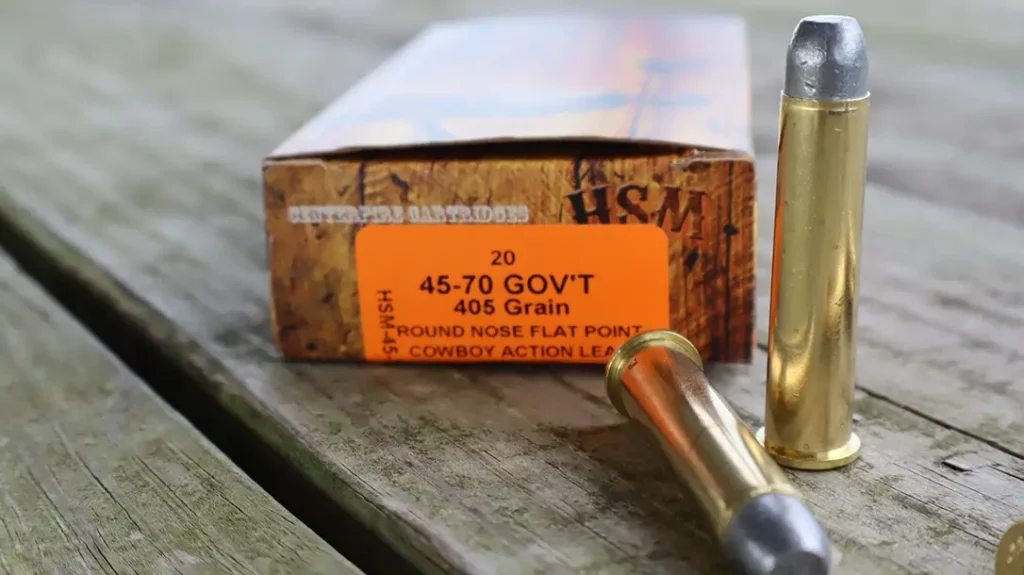
.45-70
Even though the .45-70 has been uploaded so much since its inception, that does not mean standard, or cowboy action loads are useless. These same .45-70 loads were expected to kill horses at extended distances and made its debut in the latter years of the great buffalo hunts in the late 1870s. These big bullets had more momentum than the velocity figures would suggest.
On the Range
To properly test the Pedersoli Trapdoor Springfield is to make it as part of the kit that would be used by a woodsman or cavalryman of the era. Unfortunately, the budget for a horse and wool uniform is too high. But what I could do is tailor the ammunition. I shot the Pedersoli Trapdoor Springfield with HSM and Winchester 405 grain factory loads, but I also tried my hand with my reproduction of the US Cavalry load. That load consisted of a 405-grain lead bullet backed by 55 grains of black powder.
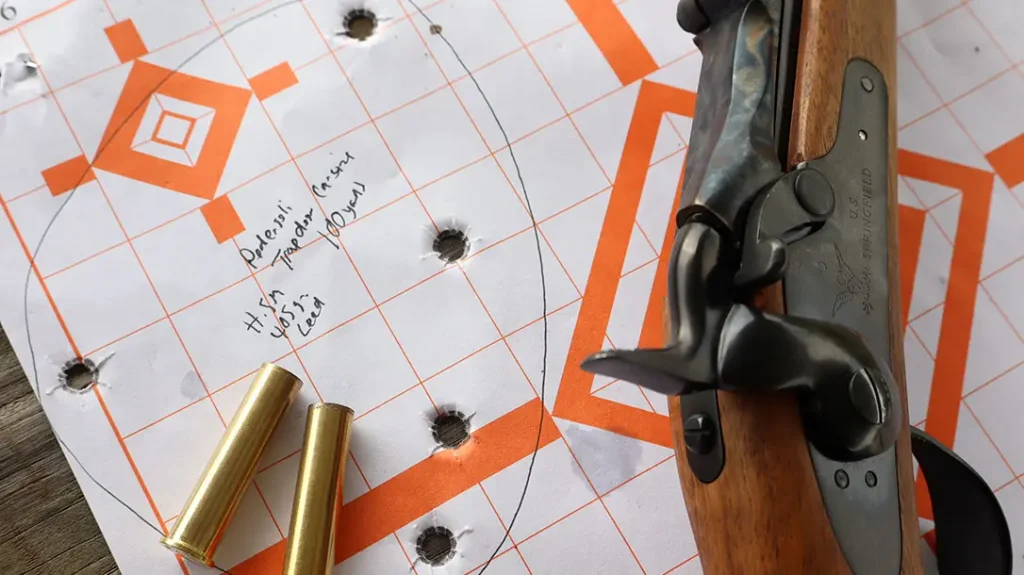
Initial Impressions
I started out by putting the Pedersoli Trapdoor on paper to see where the sights hit. Since both the rear sight and rear sight are brazed in place, there are only a few crude ways to adjust windage. Elevation would be no problem thanks to the ladder sight. I set the sight at its lowest setting and benched the Springfield.
Loading the Springfield is swift for a single-shot rifle. Bring the generous hammer back to the half-cock position, pull up on the lug catch on the right side and swing the trapdoor up and over. Insert a round into the chamber and close the door. Cock the hammer to full cock and press the trigger to fire. If you are in a hurry, it is just as easy to bring the hammer to full cock and then load.
HSM 405 Grain Lead Flat Point
I started out with some HSM 405 grain lead flat point rounds. These are smokeless loads kept to an advertised 1,300 feet per second. They certainly look the part of the issue ammunition. Out of this light carbine, these rounds produced substantial felt recoil from the bench. Wearing little more than a waffled cotton long-sleeve shirt, the steel butt plate more than said hello.
Working past the recoil, I was able to post a decent group at 50 yards, although it was several inches low and to the right. At this distance, the sights and trigger are no excuse. Unlike other replica makers, Pedersoli tends to equip their guns with a solid trigger. The trigger on the Springfield measures in at 3 ¾ lbs. and has just enough mechanical mush to know the trigger is slipping the hammer’s sear. The sights at the lowest setting are almost even with the notched hinge of the trapdoor, but the triangular front sight stands out in stark relief against the small bullseyes I took aim on.
Winchester 405 Grain Load
I next tried the Winchester 405 grain load. This one is advertised at 1,150 feet per second and on the shoulder it is a little more sedate. I next tried my black powder Carbine load. It smokes, it smells, and it is surprisingly manageable. As with so many things, numbers alone do not tell the story. You can load smokeless ammunition down to black powder pressures but the burn rate and pressure spikes are different. What results on the shoulder is more of a disorderly push than an Ezzard Charles right hook.
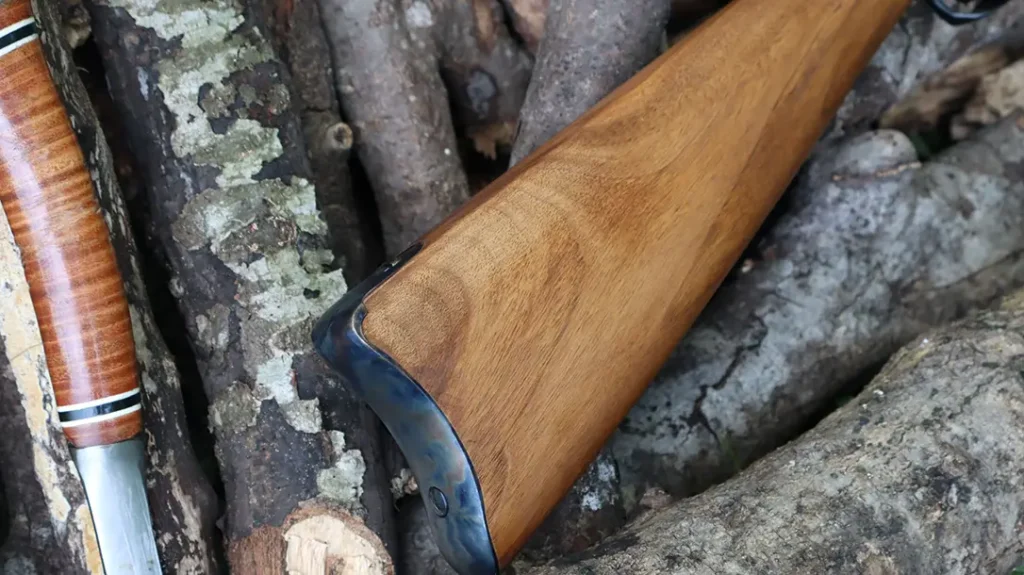
Accuracy
After getting a feel for the Trapdoor, I stayed at the bench but extended the distance out to 100 yards to see if the sights would be truer. Instead, the tendency to hit low and close to one foot right was the result. Adjusting the sights to 200 yards only put me higher on the target.
The Trapdoor is MOA of man and beast, but not a sure contendor for a bowling pin match. In terms of accuracy, I could keep four rounds of the HSM and the Carbine load into a four inch group at 100 yards. But I always seemed to throw the fifth round to create a persistent seven-inch pattern. The Winchester load sat just behind that. I also tried some sedate 300 grain jacketed bullet loads that did not even begin to group. Given the twist rate and characteristics of the Pedersoli Trapdoor, a lead bullet with a higher bearing surface is where it is.
Moving and Shooting
The Pedersoli Trapdoor Springfield is something of a tale of two rifles. Immobile, slow, and hard kicking from the bench with decent accuracy. Although the sights required some Kentucky windage, the Trapdoor comes alive on the move.
Off the cuff, the 1873 Carbine is light and ready to point in not so similar a fashion as a Winchester 1873. With the Trapdoor you only get one round at a time, but it is one big round with longer legs. Even with that limitation, the Trapdoor is surprisingly nimble. I employed the period trick of tucking the ammunition into the fingers of my support hand.
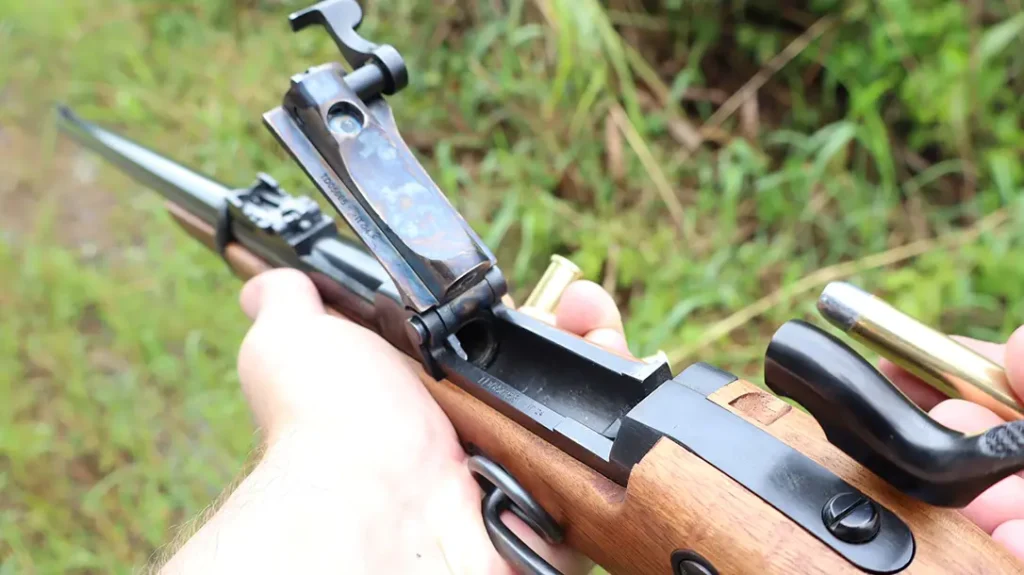
Shooting Process
After firing a round, I would draw the hammer back to full cock, open the action to eject the empty, reload, close, and fire again. In a pinch, I could get two rounds off in six seconds. But there is some technique required. Replica Trapdoors tend to have weak extractors and the stationary ejector on this one kicks the case out by a few inches with a brisk snap of the door. It also helps to keep the carbine pointed downward so the door doesn’t shut with gravity.
Another added benefit of going on the move is that your shoulder is not eating all the recoil energy as it would from the bench. All loads became more manageable, and I could get through a string of fire without switching shoulders. The Carbine load was a downright joy and occasionally beaming a 200-yard gong a full two seconds after firing a shot invited one too many belly laughs.
The Trapdoor Springfield: Undervalued and Not to be Outdone
Producing a replica of an extinct firearm is a balancing act. Makers have to balance potential utility as an actual shooting iron while ensuring the model they are recreating will be popular enough to sell to history enthusiasts. For those reasons, only the most iconic make it off the factory line. The Colt Peacemaker and Winchester 1873 were universal arms for decades and earned more memory on the silver screen.
While the .45-70 cartridge is perhaps more popular than ever, the rifle that started it is something of an enigma. The 1873 Springfield and the US Cavalry didn’t get the TV and movie treatment to ensure its status, but we live with its legacy even today. What the Springfield lacks in Western individualism, it makes up for it with efforts on a greater scale. With all of its supposed faults, the Trapdoor marked an end of the feigned innocence of an infant nation state and the beginnings of a world power. For that reason alone, the Trapdoor Springfield earned its place in the replica world and Pedersoli is living up to it very well.
For more information, visit Pedersoli.
Pedersoli Springfield 1873 Carbine Quick Specs
| Caliber: | .45-70 Government |
| Capacity: | 1 |
| Barrel Length: | 22 inches |
| Overall Length: | 40.75 inches |
| Length of Pull: | 13 inches |
| Weight: | 7.8 lbs. (unloaded) |
WHY OUR ARTICLES/REVIEWS DO NOT HAVE AFFILIATE LINKS
Affiliate links create a financial incentive for writers to promote certain products, which can lead to biased recommendations. This blurs the line between genuine advice and marketing, reducing trust in the content.


